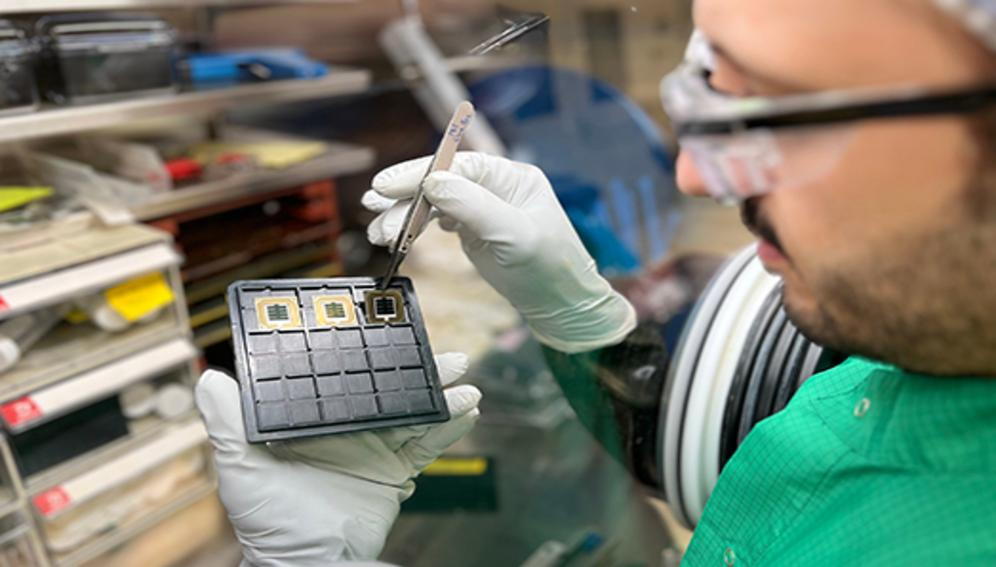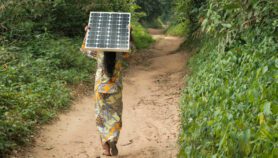By: Hazem Badr
Send to a friend
The details you provide on this page will not be used to send unsolicited email, and will not be sold to a 3rd party. See privacy policy.
[CAIRO] A pioneer in combining two types of solar cells is aiming for a new world record after his team achieved the highest ever conversion rate for the technology.
The so-called tandem cells add perovskite to the standard silicon in order to absorb more of the sun’s spectrum, boosting their efficiency.
Researcher Erkan Aydin, a member of the team at the King Abdullah University of Science and Technology in Saudi Arabia, tells SciDev.Net of his hopes for the new technology.
What are tandem solar cells?
They are cells that combine perovskite and silicon. Their manufacture depends on covering the surface of micrometre-sized silicon cells with perovskite, and the combination works to increase the absorption of sunlight and convert it into electricity more efficiently than conventional silicon cells.
What is the mechanism behind this high efficiency?
The idea is that the top perovskite layer better absorbs blue light from the sun’s spectrum, and the silicon base layer absorbs red light. This increases the capture of sunlight and thus increase the efficiency of energy conversion.
How were you able to break the world record in energy conversion using those cells?
It didn’t come overnight. We at King Abdullah University of Science and Technology have been working on these cells for seven years, and now our solar energy centre is one of the best.
We would like to continue the research to prove the full potential of this technology, in addition to focusing on scalability of manufacturing methodologies.
So, should we expect new percentages to be announced soon about the efficiency of energy conversion using these cells?
We have now reached a difference of about 11 per cent in energy conversion efficiency between conventional cells and new tandem cells, and we aim to reach about 20 per cent.
You have achieved an advantage in these cells’ efficiency, but what about its price and sustainability?
By incorporating the processing of perovskite cells onto silicon wafers, the incremental cost of these cells is expected to be minimal due to the simplified processing steps, and we are currently working on testing their lifespan, but I don’t imagine it will be much different from silicon cells.
What about working in harsh climates? Could that tandem cell match an earlier feat of the Helmholtz Berlin Centre for Materials and Energy, whose researchers succeeded in developing cells that operate in extreme climates, from minus 60 degrees Celsius to 80 degrees Celsius?
Tandem cells are still under scrutiny and experimentation using accelerated test protocols, and our research team has performed a relative temperature test … to evaluate the performance of the cells under extreme conditions.
Test protocols include a thermal cycle test, which subjects the cells for temperatures between 40 and 85 degrees Celsius , to simulate the effects of weather. Our research team is working hard on conducting the thermal cycle test and documenting its results.
Are there future experiments that will be conducted on this cell after manufacturing it in larger sizes to test the extent to which the same benefits are achieved in large sizes?
There are many companies and research institutions that are actively involved in research programs aimed at expanding the scope of tandem solar cell technology, and one of the prominent institutions that is making great efforts in this direction is the King Abdullah University Centre for Solar Energy.
Despite what has been achieved at the research level, what about the availability of raw material in the Arab environment?
Certainly, the Kingdom of Saudi Arabia does not currently have a well-established industry in the field of the most famous solar cells, which are silicon cells. On the other hand, perovskite solar cells belong to an emerging field, and this represents an opportunity for Arab countries, including Saudi Arabia, to develop the raw materials needed to manufacture these cells.
Since you now own the manufacturing technology, is there any thought for King Abdullah University of Science and Technology to launch a company that will invest in these cells?
[King Abdullah University of Science and Technology] does not currently have an initiative to establish a company for this purpose. However, we are in contact with some international photovoltaic manufacturers to seek industrial cooperation.
When do you expect tandem cells to become commercially available?
Many companies have announced their commitment to develop programs related to the manufacture of tandem cells parts, and these cells are expected to appear for the first time in the market by 2030. The introduction of such products has the potential to revolutionize the solar energy industry by providing highly efficient and cost-effective solutions to generate electricity.
Market forecasts estimate that tandem cells will capture more than US$10 billion of the global photovoltaic market share by 2032.
How do these solar cells support efforts to combat climate change?
Tandem solar cells made of perovskite and silicon together are of great interest as a future photovoltaic technology. Because they promise high levels of energy conversion efficiency at a reasonable cost, they can contribute to accelerating the transition to clean energy sources.
This article was produced by SciDev.Net’s Middle East and North Africa Regional Office.
















